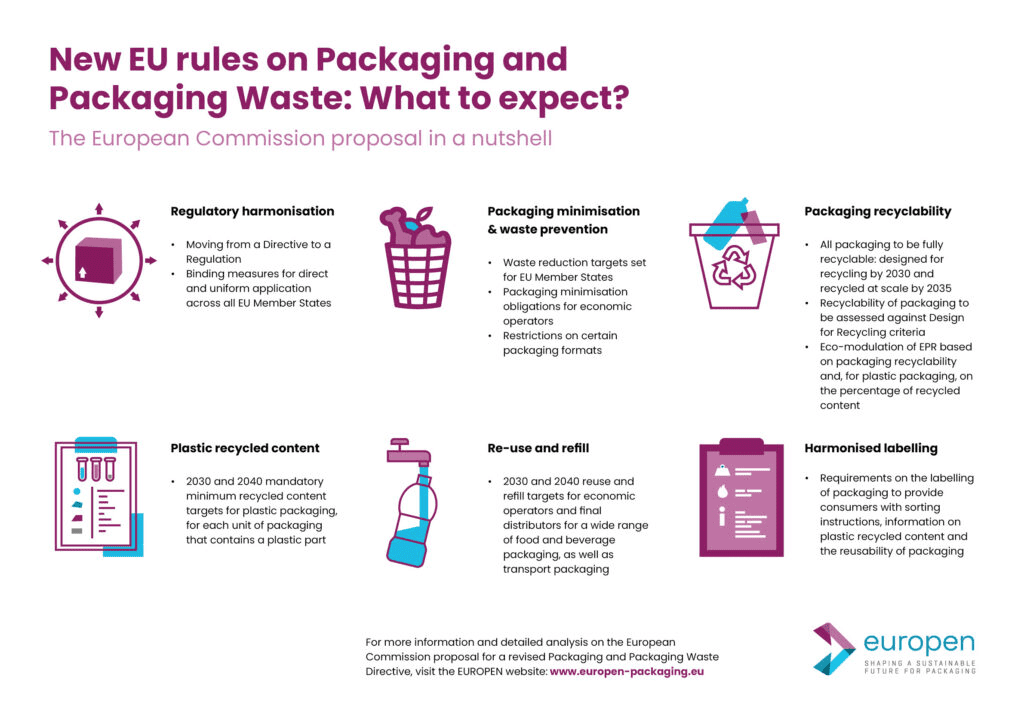World Environment Day this year, under the theme “Beat Plastic Pollution,” emphasizes the urgent need for businesses to critically examine their environmental footprint. With a particular focus on plastic pollution and packaging waste , this call to action is not just ethically driven, but also mandated by legislative acts like the EU Packaging and Packaging Waste Directive (PPWD), which will become an EU-wide binding rule known as the Packaging and Packaging Waste Regulation (PPWR).
What is the EU Packaging and Packaging Waste Directive, and why is it needed?
The PPWD, originally introduced in 1994, seeks to harmonize measures on packaging waste management, prevent waste production, encourage reuse and recycling of packaging, and bolster other forms of waste recovery. The Directive applies to all packaging and packaging waste, regardless of the material used, and it adheres to the EU waste hierarchy, which gives the highest priority to waste prevention, followed by preparing for reuse, recycling, other recovery and finally disposal.
However, with the growth of the packaging market comes significant environmental repercussions. From 2009 to 2020, packaging waste in the EU increased by 20%, reaching 79 million tons in 2020. Recycling rates did improve slightly from 63% to 64% but have been stagnant since 2016, underscoring the pressing need for more effective packaging waste management solutions.
The Revised PPWD: Soon to be the PPWR
In 2018, the PPWD was revised to include higher overall recycling targets for packaging (65% in 2025 and 70% in 2030), as well as higher material-specific targets, such as 55% for plastic by 2030.
In the most recent proposed revision, introduced on November 30th, 2022 as part of the European Green Deal’s Circular Economy Action Plan, the Commission has set a more ambitious target: to ensure that all packaging is reusable or recyclable in an economically feasible way by 2030.
The new PPWR proposes specific design requirements to ensure recycle-ready packaging and the increased use of Post Consumer Recycled (PCR) content in plastic packaging. Suggested “eco-modulation” criteria for Extended Producer Responsibility (EPR) schemes would lower fees for packaging that meets these requirements. This shift is a notable effort to reduce waste and create a stronger internal market for recycled plastics and innovative packaging solutions, leading to the promotion of fair competition among packaging manufacturers.
Another key element introduced by the proposal would turn the current Directive into a Regulation, meaning that most requirements would apply directly to economic operators, ensuring harmonization across Member States.
If approved, the new regulation would mean that by 2030 all packaging on the EU market must be designed to be recyclable (i.e., recycle-ready), with most healthcare packaging needing to meet that requirement by 2035. By 2035, businesses will need to demonstrate their packaging is recycled at scale, which requires having the appropriate recycling infrastructure in place.
Key provisions in the revised PPWR include:
- More stringent requirements for recyclable packaging.
- The introduction of waste prevention targets and measures for packaging minimisation.
- The setting of reuse and refill targets for various types of food and beverage packaging.
- Mandating minimum recycled content in plastic packaging.
The implementation of PPWR will result in some key outcomes:
- Establishes clear and uniform rules concerning packaging that will support long-term strategic planning for cost-effective packing investments.
- Effectively prevents packaging waste leading to reduction in expenses incurred during waste collection and treatment.
- Supports positive impact on internal markets, better supporting strong sustainable waste management infrastructure to provide reliable and consistent pathways to reduction.
- Anticipates a significant shift to reusable packaging, increased recycling, and the development of a more competitive secondary materials market delivering job creation opportunities.
- Measures aimed at reducing waste generation via packaging would necessitate the adoption of new business and consumption models that will impact consumers, manufacturers, brands, and retailers.
There are also steps toward encouraging the use of compostable packaging in specific applications and standardizing packaging labeling requirements across the EU.

Source: Europen
Confronting the Challenge: A Strategic Approach Toward Sustainable Packaging
Navigating the implications of the revised PPWR will require a strategic and systematic approach. The complexity of packaging supply chains, diverse packaging materials, and varying levels of supplier compliance can make this a challenge. Here is a step-by-step plan of action to help guide you:
- Gain Visibility. Get a clear picture of your supply chain, particularly your suppliers’ use of packaging.
- Evaluate Current Practices. Assess your suppliers’ packaging practices to identify what types of packaging materials they use, the volume of waste generated, and their current recycling and waste management protocols.
- Set Clear Goals. Align your business goals with the PPWR principles to promote waste prevention, reusable packaging, and increased recycling rates.
- Implement Changes. Collaborate with your suppliers to initiate necessary changes, such as minimizing packaging, sourcing alternative materials, or investing in recycling initiatives.
- Monitor Progress. Regularly review supplier practices to ensure compliance with sustainability standards and the PPWR.
Harnessing the Power of Data: A Tool for Plastic Waste Reduction
As businesses respond to the proposed PPWR, one of the most pressing concerns is plastic waste, given its prevalent use and environmental impact. Here, a data-driven approach is crucial. SupplyShift’s Plastic Packaging Assessment emerges as a vital tool in this process, offering comprehensive visibility into suppliers’ use of plastic packaging, ensuring regulatory compliance, and identifying waste reduction opportunities.
The Plastic Packaging Assessment tool enables businesses to:
- Identify Risks and Gain Insights: Understand the extent of plastic use in your supply chain, pinpoint potential risk areas, and use these insights to create effective strategies to drive sustainability.
- Benchmark Performance and Align with Regulations: Assess your suppliers’ packaging practices, evaluate practices against industry standards, and set clear goals for improvement.
- Engage Suppliers and Reduce Waste: Promote a collaborative approach with suppliers to drive meaningful change by identifying opportunities for waste prevention, packaging reuse, and improved rates of recycling and recovery.
- Prepare for the Future and Track Progress: Anticipate future legislative changes, such as the mandatory recycled content in packaging, and monitor progress over time to maintain compliance and measure the success of sustainability initiatives.]
In addition to plastic, businesses can utilize similar data-driven tools for other types of packaging materials, ensuring a holistic approach to sustainability. SupplyShift’s diverse suite of Standard Assessments is designed to help guide businesses through this evolution.
Bracing for Impact: The Future of Packaging in the EU
The proposed revisions to the PPWR will undoubtedly impact many businesses operating in the EU, requiring them to reassess current packaging practices and strategies. However, while these changes may present initial challenges, they also provide opportunities for organizations to innovate, improve sustainability, and gain a competitive edge.
The rising consumer demand for environmentally friendly products and services means that businesses that successfully transition towards sustainable packaging are likely to reap considerable benefits. And beyond the business advantage, companies will be contributing to the global effort to reduce waste and combat climate change, thus playing their part in creating a more sustainable future for all.
Let’s strive to shape a future where economic growth and environmental sustainability coexist harmoniously. Contact us to discover how SupplyShift can empower your business to respond to the new EU Packaging and Packaging Waste Regulation, drive waste reduction, and champion sustainability across your entire value chain.



